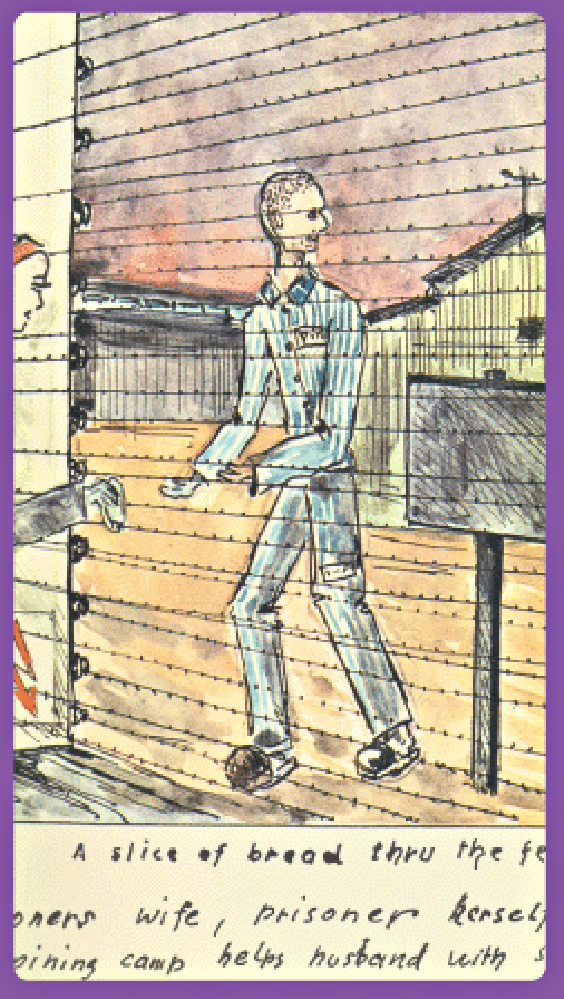(…read in spanish)
Subscribe to Kurioso in english 
.
Terezín was the nazi concentration camp located at Prague’s outskirts. The “Lobby of the hell” was the last stop for 150.000 Jews and 15.000 kids and pre-teenagers. A woman –Friedl Dicker Brandeis– dedicated her time during the internment teaching stealthily art and paintingas evasive therapy for many of those kids. Before leaving Terezín for going to her final destiny, she rescued 4.500 drawings. These drawings were used as clues during Nuremberg’s Trial, and they’re an indelible sample of the horror.
«Everyone was hungry» Liana Franklová 10 years old. Terezín
.
Friedl Dicker achieved that those kids remember through the drawing the life they were pulled out besides representing the sad and horrible truth of the concentration camp. Above all, the kids could move their selves with the painting into a world of fantasy and imagination, where the good remained over the evil, there was free will and hope in the way. Drawings representing their coming back to home, everyday scenes and desires of freedom are constant. But Friedl Dicker respected the personality of each child and let them puke and open their imagination to the perceptions about the atrocity of the concentration camp. Just 100 of the 15.000 kids survived Terezín after all. Lots of the drawings have an excellent quality despite the age of their authors. In fact some of them were renowned artists years later, thanks to Friendl Dicker Brandeis’s work.
.
Helga Weissova. 13 years old. She tells in this drawing how the Germans forced them to reduce the bunks, with the aim of trying to make the hut appearance less narrow and then cheat the Red Cross inspection. Terezín.
.
Ella Liebermann. 16 years old. Very tight, the jews from every part of Europe were sent to the death. Bedzin’s ghetto. Poland.
.
.
.
Edita Pollakova. 9 years old. The deportation train arrives at Terezin. Edita died the October 4th of 1944 at Auschwitz.
.
Ella Liebermann. 16 years old. Eating and soup distribution. Bedzin’s ghetto. Poland.
.
Helga Weissova. 13 years old. Drawing titled “Terezín arrival”. Helga entered in the concentration field with just 12 years old. She brought a box with paintings and a notebook. She draw more than 100 paintings doing what her father told her: “Paint whatever you see”. Here ended Helga’s childhood. With the responsibility of painting everything she saw and experienced. She was one of the few survivors.
.
Helga Weissova. The last drawing of her series, made at Terezín’s exit in 1945. Everything can be sensed in the children’s look.
.
Yehuda Bacon. Being 16 years old he drew this portrait of his father recently gassed and burnt at Auschwitz. The face of his father emerges emaciated through a curtain of smoke. Impressive.
.
Link and sources
I came up with Terezín before watching the drawings of the Spanish kids of the Civil War. I thought that the Holocaust should have its own “painter kids” and I found documentation about this here, here, here, here and here. Friedl Dicker’s history and lots of those paintings can be found in the book “Fireflies in the dark” and here. Ella Liebermann and Helga Weissova survived the Holocaust and became famous artist. Helga has followed the steps of her mentor –Friedl Dicker– and is dedicated to educate others about the disgrace. Ella Liebermann continued painting until her death in 1988.
.
See also from Kurioso:
-The man who smiled from the grave.
-Madrid, yesterday and nowadays.
-The odyssey of the Spanish tomato
.
 Thanks to @eddiedean for translating this post
Thanks to @eddiedean for translating this post




































cringe lord
/ septiembre 19, 2018…. this is depressing and exciting at the same time
Camilla
/ marzo 8, 2017I had to come back and reread this post. The art the Terazin kids created is both horrible for the lives they depicted suffering, but amazing for the insight and details and amazing journalism they portray. Journalism without words. Wow. Thank you!
ricardo rol a
/ noviembre 19, 2014Veri bao Gostei mt goody
yrawpkvmtmru
/ May 6, 2013xtpridcghfmz
drwxlhhcmcld
/ May 6, 2013czrrnbsrkump
hgtfqpqcwaot
/ May 6, 2013ammquykapnjq
hjkpazmlcsjv
/ May 6, 2013lmhwtazrcehp
Sandra Mendes
/ abril 25, 2013Very beautiful post! Very sad memories of holocauste.